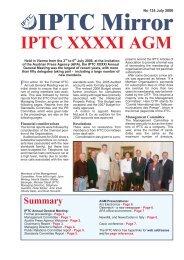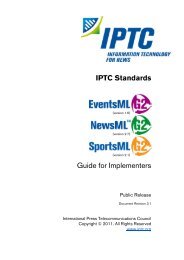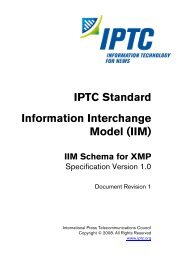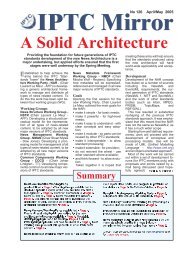Mirror 136 - International Press Telecommunications Council
Mirror 136 - International Press Telecommunications Council
Mirror 136 - International Press Telecommunications Council
You also want an ePaper? Increase the reach of your titles
YUMPU automatically turns print PDFs into web optimized ePapers that Google loves.
No <strong>136</strong> November 2006IPTC <strong>Mirror</strong>Autumn Meeting 2006A high level of activity leading up to, and during, theAutumn Meeting resulted in further progress on developmentof the NAR, and a new system of Subject NewsCodes, alongwith new releases of the NITF and SportsML.Opening the Meeting IPTC ChairStéphane Guérillot (AFP) welcomeddelegates, including a newmember NewsCom (www.newscom.com).He then informed members thatthe IPTC Rules of Order (whichgovern the conduct of all Committees,Working Parties and WorkingGroups) have been modified to allowthe possibility of inviting nonmembersto take part in the activitiesof Working Groups - thischange was made at the request ofthe NewsCodes and PhotometadataWorking Groups.Access ProtocolStéphane also drew members attentionto the ACAP (AutomatedContent Access Protocol) which isbeing developed as an industrystandard by the publishing industry.It is intended to enable the providersof all types of content publishedon the World Wide Web to communicatepermissions information (relatingto access and use of thatSummaryOrganisationRules of Order revised - Page 1. AutomatedContent Access Protocol - Page 1.StandardsCommitteeRoadmap revised - Page 1. PhotometadataWorking Report Charter and aims - Page 2.Photometadata event 2007 - Page 2.NewsML Architecture Working PartyRelease Candidate under preparation - Page 2.News Content Working PartySportsML V1.8 approved - Page 2. SportsML-G2advantages - Page 3. EventsML-G2 update - Page3. NewsML-G2 content handling - Page 3.NewsCodes Working PartyNew generation Subject NewsCodes - Page 4.content) in a form that can be automaticallyrecognized and interpreted.The project is an initiative of TheWorld Association of Newspapers(WAN), the European Publishers<strong>Council</strong> (EPC) and the <strong>International</strong>Publishers Association (IPA). IPTChave expressed a wish to be involvedin the project and have contactedthe WAN - who are IPTCMembers - on this matter.StandardsA revised version of the standardsroadmap was released prior to theAutumn Meeting. For the NAR, updatedspecifications and a releasecandidate XML Schema wereplanned for November 2006 with afinal report at the Spring Meeting2007 (Cairo 12 to 14 March) followedby formal approval at the2007 AGM (Tokyo 28 to 31 May).Note that subsequent developmentsare liable to affect thisschedule - see the NAR report forfurther information.Draft specificationsIt was hoped that draft specificationsand XML Schemas would beavailable for both NewsML-G2 andEventsML-G2 by the end of 2006,so a first experimental phase couldbe started, leading towards final approvalof the standards at theAutumn 2007 Meeting.ApprovalsFollowing normal practice the secondStandards Committee session(following the working sessions) receivedprogress reports from theWorking Parties and considered aseries of motions:• A request for the Working Groupsin the News Content WorkingParty, and the NewsCodes WorkingParty to evaluate the new draftof the NAR and provide writtenfeedback;• Approval of SportsML 1.8;• Agreement to group the News-Code sets by application, andcorrection of an error in the Sportssection of the Subject News-Codes;• Approval of NITF 3.4.Details of the work resulting inthese motions are given in the indi-NewsCodes grouped for easy recognition - Page 4.Taxonomy Management - Page 5. FurtherNewsCode translations available - Page 6.NITF Maintenance Working PartyNITF V3.4 approved - Page 6. Proposal for coreand power versions of the NITF - Page 7.NewsML 1 Maintenance Working PartyNewsML 1.2 XML Schema under test - Page 7.Validation problems using XML Spy 2006 - Page 7.Public Relations Committee - Page 7.Agencia EFE - Page 3.MESH Update - Page 4.The Challenge of New Media - Page 6.The IPTC <strong>Mirror</strong> has hyperlinks for web addressesand for page references.
Harald Löffler,Co-Chair of thePhotometadataWorking Group.vidual Working Party reports on thefollowing pages.PhotometadataThe new Photometadata WorkingGroup reports directly to the StandardsCommittee and presented itsfirst report. Working Group Co-Chair Harald Löffler (Ifra) outlinedprogress to date, starting with theproposed Charter:• Act as a special interest group regardingall photo metadata relatedissues within the IPTC. Thework is not focused on a singlestandard, but will support all currentIPTC standards in all photorelated areas.• Support the development of genericIPTC photo metadata standards.• Act as a standing group of expertsto respond to issues raised by externalparties.He went on to explain that specifictasks for the Group have beenidentified including:• Collaboration with Ifra on the issueof “preserving EXIF-JPEGmetadata” to support the idea of aseamless automated workflow tothe publisher. A paper dealingwith this will be presented at theCairo (Spring 2007) Meeting.• Further development of the IPTCCore with enhancements andtranslations, and further cooperationwith Adobe.• A review of other photo metadatastandards.• Preparation of a “PhotometadataEvent” - see panel.User surveyFollowing the Autumn Meeting asurvey was set up, to establish howsoftware providers support theIPTC photometadata standardsand how metadata values are synchronised.The survey is at(http://www.iptc.org/photometadata/swimplsurvey.php).Althoughthe survey is ongoing, initial resultshave been collated by MichaelSteidl (also Co-Chair of the WG)and a list of 49 packages is nowavailable - http://www.iptc.org/photometadata/softwaresupportlist1.php.News ArchitectureOutlining the status of News Architecture(NAR) development, WorkingParty Chair Laurent Le Meur(AFP) explained that efforts werebeing concentrated on the productionof a NAR Release Candidate,with the draft model and specificationand associated XML Schema.The NewsContent Working Groupsand the NewsCodes Working partywould then be asked to carry out anevaluation.However discussions - before,during and after the working session- resulted in an extensive seriesof comments and requirementsthat had to be considered beforethe Public release version could becompleted. This work is under wayand further details of the NAR sessionat the Autumn Meeting, andsubsequent work, will be given inthe next issue of the IPTC <strong>Mirror</strong>.NewsContentOpening the session acting ChairHenrik Stadler (TT) pointed out thatthere was still only limited involvementin the development processfor the new content standards, somore volunteers to help with thework would be welcome.SportsMLDevelopment of SportsML continuessteadily with proposals for aSportsML 1.8 release being outlinedby Working Group Chair AlanKarben. Additions to the Core includeenhancement of the and addition of a (for players), along with anPhotometadata Event 2007INFORMATIONTECHNOLOGYFOR NEWSextension of the to cover sports events as a whole.Baseball correctionsA number of errors in baseballspecificplug-in for SportsML 1.7had been reported by a MajorLeague Baseball Club who suggestedmoving one of the elements; renamingone attribute (now reached-basedefensive-interference);redefininganother attribute (pitch-type); andcreating a new attribute (umpirecall). These changes were consideredappropriate - as they helpedthe plug-in provide a better modelof the game - but mean that the revisedversion will not be backwardscompatible with previous versions.In addition the baseball plug-inwas extended to give more detailson the pitch and any strike.Plug-insAdditions have been made to thetennis plug-in, mainly to provide detailsof serves, returns and volleys.There is also a new plug-in tocover curling - this was developedby Johan Lindgren (TT).ApprovalFull details of the additions andchanges are available fromwww.sportsml.org/dev. After somediscussion the additions andchanges were approved, but therewas some concern that they hadnot been fully documented and reflectedin both the XML Schemaand the DTD versions.However the appropriate work wascarried out before the end of theMeeting, and adoption of the completedSportsML 1.8 was thenPlanned to take place during the 2007 CEPIC congress (June 6to 9, in Florence, Italy) the Photometadata 2007 event isintended to bring together a wide range of parties who areinvolved in the creation, storage and use of photo metadata.This would include: Users - photographers, stock and news photoagencies, photo libraries, archives and publishers; Implementers -software and system vendors involved with imaging, workflow andarchiving, along with camera manufacturers. Standards bodies -including IPTC, PLUS (Picture Licensing Universal System), theEXIF maintenance body, and IDEAlliance (Prism - PublishingRequirements for Industry Standard Metadata)Participants would provide information about workflowrequirements and existing standards, look at implementation issues,and consider how to specify standards so they do not overlap.Initial sponsors are Ifra, IPTC and CEPIC. For IPTC the eventwould also provide a further public example of its work as aninternational standards body, while Ifra would reinforce its positionas the industry body pursuing a consistent implementation ofstandards for the sake of printing quality.IPTC <strong>Mirror</strong> November 2006 Page 2
moved directly in the StandardsCommittee.SportsML-G2Alan Karben then went on to considerreasons behind the introductionof a SportsML-G2.For publishers it would offer additionalpublishing and rights managementfunctionality along withimproved versioning features.Sports news articles would benefitfrom the improved metadata. Generaluse of the new standard mightalso offer the possibility of contentneutralplatforms for content permissioningand distribution.For users, the common metadatamodel could be used for routing andprocessing, while they could alsobenefit from content-neutral platforms.Some initial experimentalSportsML-G2 samples are availableon www.sportsml.org/dev. TheSportsML 1.8 package is also atthis location.EventsML-G2A look at the status of EventsML-G2 was provided by Johan Lindgren(TT) who explained that a widerange of information would be associatedwith an actual event. Thisranged from calendars and daybooksto the interchange of eventsinformation, along with assignmentsand other actions associatedwith coverage of the event. In somecases historical references wouldbe involved, while one end resultwould be the production of newsstories.Handling eventsA first consideration was to establishhow an ‘event’ should be fittedinto the NAR structure, with threeoptions being to use the existingConcept Item, or NewsItem, or tocreate a special EventItem (basedon the NAR AnyItem). Developmentof a structure to handle informationspecific to an event hasresulted in an eventDefinition thatcan be used in a number of ways,such as in a NewsItem or a ConceptItem.Date and time information is anessential part of EventsML-G2 witha series of use cases having beendeveloped. Start (and End) Dateand Time can be dealt with by usinga Partial Date-Time Type, while thepossibility of using the iCalendarmodel to deal with recurring datesis being investigated.Much of the information to describethe ‘What’ of an event isabout is already available in theNAR, such as details about participants,the subject of the event, andthe organisers.NewsML-G2Intended for general journalisticcontent, NewsML-G2 will handle,for example: text articles; photos;graphics; audio and video; illustratedarticles; and multimediapresentations. Working GroupChair Laurent Le Meur (AFP) explainedthat, in effect, the commonfunctions from NewsML 1 havebeen taken into the NAR, while thegeneral news markup is taken careof by NewsML-G2.Agencia EFE is a major international newsagency with services in Spain and Europe,South America and the United States.Starting - in 1939 - as a press agency offeringSpanish text news services, EFE began itsinternational expansion in 1965, opening anoffice in Buenos Aires, Argentina.With its headquarters in Madrid, EFE now has25 offices in Spain and 35 abroad, with smallbranches and correspondents in 150 cities from100 countries. Daily output is more than 3000 textitems (in Spanish, Catalan, English, Brazilian,and Arabic), 1200 pictures, and a range of video,audio and multimedia services.The communication system is based on acombination of a VSAT (Very Small ApertureTerminal) satellite network with world-wideINFORMATIONTECHNOLOGYFOR NEWSNewsItemThe key element of NewsML-G2 isthe NewsItem (which consists ofmetadata and content), with allprocessors having to be able tosupport standardised NewsItemprofiles. The NAR Concept, Knowledgeand Package Items are alsoincluded in NewsML-G2 but are notan essential part of the standardand may be ignored by NewsML-G2 processors.At the moment efforts are beingdirected to the implementation ofspecific sections of the new standard.Photo contentFor photos this includes: defining alist of physical characteristics; andAgencia EFEAn overview ofAgencia EFE wasprovided at theAutumn meeting byJose Luis del Rey.broadcast coverage and simultaneous push-pull services on a IP(Internet Protocol) network with the main node in Madrid.DatabasesMain commercial databases are EfeData and Fototeca, which hastwo million pictures dating from 1998.EfeData is the EFE historical text archivecovering the past 20 years and providesnews items and journalistic information,biographies and documents in Spanish aswell as historical news items in Catalan,English Portuguese and Arabic. Spanishcontent includes all EFE output since 1988with 15 million news items and over 15thousand biographiesOver time EFEData has undergone a seriesof technical changes to meet new demands.Manuel Fuentes When launched in 1986 it used BASIS-K, adescribedfull text database hosted on a MicroVAX. Thedevelopment of thecurrent system uses TaWeb, a full textEfeData database.information system. IPTC standards are used- NITF 3.2 and the Subject NewsCodes forclassification.A major development was the arrival of the Internet with EfeDatabeing the first product that EFE offered on the new media.IPTC <strong>Mirror</strong> November 2006 Page 3
producing a bi-directional mappingbetween the IPTC Core andNewsML-G2, with a particular problembeing to find a way of handling‘traditional’ keywords. It is hopedthat information to help with this willcome from the new PhotometadataWorking Group.Video contentThe EBU have provided a series ofspecific requirements for video: a‘shot list’ giving a structured descriptionof segments of the content;handling of remote content in astream or on removable media; andprovision of separate physical metadatasets of media channels(audio and video).However these requirements arecomplex and carry a risk of overloadingthe NewsItem. Also neededfor video (and audio) are sets ofphysical properties and detailedtime references.RightsThe EBU have also made someproposals for handling rights,based on the practice in other EBUapplications.SpecificationAn important step is to draft a specificationdocument, which will be referencedto the NARdocumentation. The specificationMESH Updatewill be processing oriented withtypical implementation examplesincluding:A photograph in multiple resolutionforms, with metadata that is compatiblewith the IPTC Core;A vector graphic with a thumbnail ofthe image;An audio clip with an accompanyinglogo;A video clip with a shot list;An illustrated article.NewsCodesA major effort is under way to developa new version of the SubjectNewsCodes with a core group ofdelegates - Amy Sweigert (Associated<strong>Press</strong>), Kirsty Crawford (BBCScotland) and Honor Craig-Bennet(<strong>Press</strong> Association) - working onthe project.Some initial conclusions werepresented to delegates at theAutumn Meeting.An underlying problem with thecurrent Subject NewsCodes is thatthe structure is very limiting, for exampleit is not possible to create relationshipsor link terms. In additionit will be necessary to change thecurrent data model for use withNAR based standards.New versionThe new version will not be limitedDetails of the MESH (Multimedia SemanticSyndication for Enhanced News Services)Project were given in IPTC <strong>Mirror</strong> Issue 135(September/October 2006) and a furtherpresentation was given to delegates at theAutumn Meeting by Paulo Villegas of Telefónica,who are a member of the Mesh consortium.Telefónica are a global telecommunicationsoperator, who use news content in a number ofservices such as TV news, 3G services and Paulo VillegasInternet news. They wan their news content tobe rich (multimedia) and adaptable, in astructured form that can be processed automatically, bepersonalised, and be amenable to rights management.Knowledge structureAn extensive knowledge structure is under development by MESH,with IPTC standards being adopted in some areas. NewsML isbeing used for news document structures and metadata, while theSubject NewsCodes were the starting point for the news domainontologies, with a first test version being produced in OWL (WebOntology Language).Initial target domains are ‘Natural Disasters’; and ‘TransportAccidents’ which have been extended by the addition of furtherconcepts. For example under ‘Natural Disasters’. ‘Earthquake’ hasthe additional concepts of compensation, focus, houses, similarincidents, and time.AmySweigertsummarisedwork thathas beencarried outon the newsystem ofSubjectNewsCodes.INFORMATIONTECHNOLOGYFOR NEWSto a three level hierarchy and willsupport polyhierarchy, allowing aconcept to have multiple parents. Itwill be possible for the same termstring to refer to different concepts,which will be differentiated byunique IDs and definitions, whilecodes will not be tied to the structure.Use of relationships may alsoallow the creation of different viewsof the codes to suit the needs of differentusers.So far as possible concepts willbe defined in a way that is culturallyneutral, and it is intended to completethe coverage in areas thathave only been partly dealt with.Updated guidelines - based on theUS NISO (National InformationStandards Organization -http://www.niso.org) Standards -will be developed for the productionof new terms and definitions.Existing versionThe existing set of Subject News-Codes would be maintained to supportcurrent users, but will remainsubject to the limitations of the currentstructure. So far as possible itis envisaged that changes to termswill be applied to both sets, whilenew terms will be also be added tothe old set, in the nearest appropriatelocation.However, the structure will be different,resulting in an increasing divergencebetween the existingSubject NewsCodes and the newversion, so it will be in users’ intereststo adopt the new version whenpossible.Taxonomy managementConsideration of the requirementsof this project resulted in investigationof the advantages of using anappropriate taxonomy managementsystem. A suitable systemhad been identified (from SchemaLogic)and a presentation of thesystem arranged for the AutumnMeeting - see panel on page 5.NewsCode groupsA proposal to split the IPTC News-Codes into groups that reflect theirapplication was raised by MichaelIPTC <strong>Mirror</strong> November 2006 Page 4
Steidl. He explained that as IPTCManaging Director he receivesmany queries about the applicationof the NewsCodes, with the mostcommon being “which of the 28NewsCodes should I use to describethe content?”. Grouping theNewsCodes by application shouldmake their use clearer, but does nothave any technical effect.The proposal was well received,and - after some discussion onwhich group was most appropriatefor some specific codes - the followinggrouping was adopted:Descriptive NewsCodes: Subject;SubjectQualifier; Genre; andScene.INFORMATIONTECHNOLOGYFOR NEWSAdministrative NewsCodes: Of-InterestTo, Provider, Status, Urgency,Colourspace, AudioCodecand VideoCodec.Transmission NewsCodes: Priority.Exchange NewsCodes: CharacteristicsProperty;Confidence; Encoding;Format; HowPresent;TaxonomyManagementDevelopment of the Subject NewsCodes willinvolve the interchange of significant amountsof material between delegates (both thosedirectly concerned, and others with specificinterests). Interchange of amendments andcomments will be an important feature of thework, while it will also be important to keeptrack of progress.Discussions between those involved lead toconsideration of the advantages of using aprofessional system for taxonomy management,resulting in a presentation to the NewsCodesWorking Party by a team from SchemaLogic(www.schemalogic.com).PresentationLowell Anderson (VP Marketing) started with a briefintroduction to SchemaLogic as an organisationwhich provides business semantics managementsystems with a corporate governance approach.Business semantics is a consensus of terms anddefinitions and SchemaLogic aim to provide astructured way of managing the process - modelthe structure (taxonomy) and informationrelationships (ontology) - govern and managechanges - publish to subscribing systems - andcollaborate to expand and maintain.PrinciplesA review of the technology used was provided byBreanna Anderson, Chief Technology Officer whostarted by outlining the underlying principles. Theseincluded:Completeness - the system is designed to addressboth structural definitions and the encoding ofinformation semantics;Neutral - to handle systems with different physicalimplementations and theoretical foundations;Flexible - to deal with systems that have divergentmanagement philosophies;Humanistic - giving consideration to humanusability factors as well as machine-orientatedperspectives;Collaborative - be directly usable by allstakeholders;Evolutionary - facilitates fine-grain and incrementalchange and evolution;Granular - to help reuse, sharing and governanceof model components.VocabularyManagement.A vocabulary can bethought of as a finite list ofterms and relationships.With the SchemaLogicsystem terms can beshared by multiplevocabularies, andrelationships can be setbetween terms in avocabulary.Relationship typesinclude Hierarchical(broader-narrower), Entry(synonym) and Related(conceptual/associative).Different views of the termsand relationships can beproduced.The system allowscollaborative managementof taxonomies, with a webbased governance system based on theBreanna Anderson,SchemaLogic ChiefTechnology Officerprovided a technicaloverview of theSchemaLogic taxonomymanagement system.Other members of theSchema Logic teamwere Lowell Anderson(VP Marketing) and GaryCarlson (ChiefTaxonomist).SchemaLogic Server. Users have to be registered(with user name and password) and may havedifferent rights - with specific restrictions on theaddition, updating and deletion of objects. Typicalchange scenarios for the NewsCodes applicationwould include browsing and searching entries,making additions, and proposing changes.Other toolsDetailed consideration of how well the systemwould meet IPTC’s needs to create and maintainthe new Subject NewsCodes took place after theSchemaLogic team had left.It was pointed out that this was an importantdecision for IPTC, as it was something that wouldhave to be lived with for some time.During discussions the availability of other toolswas raised, with specific mention of the FactivaSynaptica Knowledge Management System.Fortunately Stuart Myles (Dow Jones) was able toarrange a presentation of this system (Factiva is aDow Jones company) at short notice.RecommendationThe NewsCodes Working Party reconvened thenext morning, and after due consideration it wasagreed that the Factiva system did not meetspecific IPTC needs, and it was decided to ask theManagement Committee to consider making thenecessary arrangements for IPTC to use theSchemaLogic system.This was later done and it is hoped that thesystem will be in operation before the end of theyear.IPTC <strong>Mirror</strong> November 2006 Page 5
Importance; LabelType; Location-Type; MediaType; MimeType;NewsItemType; Notation; Property;Relevance; Role; TopicType.CorrectionNo requests had been received foradditions to the NewsCodes, butthere was a proposal to correct anerror in the Sports section of theSubject NewsCodes.On some previous occasion (possiblesome years ago) it was decidedto deprecate an entry for theAmerican Football League. However,in error the entry for CanadianFootball was marked as deprecated,leaving the entry for theAmerican League unchanged. Tocorrect this it was agreed to reinstatethe entry for Canadian Football,with the appropriateexplanation, and mark the AmericanFootball League entry as deprecated.Fast Track JuryWorking Party Chair John Mintinginformed delegates that the ‘FastTrack’ jury now had four members,in line with the revised ChangeManagement Guidelines adoptedat the 2006 AGM session.TranslationsWork on providing translations ofthe NewsCodes is continuing with anumber of new translations beingmade available in early November.These included V17 of the SubjectNewsCodes in Japanese (fromNSK), Italian (ANSA) and German(dpa), along with German versionsof the Subject Qualifier NewsCodesV 12, Genre NewsCodes V 8, andScene NewsCodes V 1 - all providedby dpa.All current NewsCodes (includingthe new translations) are availableon www.newscodes.org.NITFProposals for a NITF 3.4 were outlinedby Working Party Chair AlanKarben (XML Team).There had been a request to adda facility for including namespacedelements in the ‘enriched text’ areasof NITF instances, and it wasintended to do this by the introductionof an ‘any’ construct. It waspointed out that this change wouldonly be made to the XML Schemaversion of NITF 3.4, and not to theDTD.It was also planned to make achange to allow the use of zero ormore elements, insteadof the currently allowed zero or one,INFORMATIONTECHNOLOGYFOR NEWSThe Challenge of New MediaA look at the challenge posed by new media and the way newssyndication has changed was provided by Scott Calder(Mainstream Data) in a presentation during the AutumnMeeting.He started by outlining the position of Mainstream Data, which is amajor supplier of information distribution services to media sites inNorth America. It provides content aggregation, distributionapplications for content syndication,processing and display.Market valueLooking at the market value of ‘YouTube’ incomparison to the value of established USnewspaper publishers shows the relativelyhigh value attached to a new market entrywith an interesting concept. Also the valueof Internet companies (such as Google andYahoo) is much greater than that ofnewspapers. Overall it seems that apresence in the new media world has a high Scott Caldermarket premium.One reason for this may be thatnewspaper readership is declining (in terms of populationpercentage) while younger readers are less common - but newmedia are attracting a younger audience. Another pointer is the waythe number of weblogs is doubling every five to six months.Audience interestSo newspapers, television and radio stations, web portals andmobile service providers are all battling for the same audience. Thewinners are integrating relevant multimedia content to keep theiraudience interested; providing compelling content on web sites;adding intelligence to their content by taking advantage of contentmetadata and relevance/indexing technology; continuing to be thebest source of information for their local communities; andsyndicating their content to generate additional revenue.Mr Calder believed that actions that needed to be taken includedreducing distribution costs, delivering multimedia content in websavvycontents, and the development of new platforms forinformation exchange.Content syndicationHe went on to describe how the model for content syndication waschanging. With the 20 th century model information for contentproviders passed through distribution platforms to the media users(newspapers, broadcasters and web sites. Now there is a feedbackloop with content from the media flowing to other media and back tothe content provider. The next stage will introduce a body of “citizenjournalists” providing content to the providers and direct to themedia.Success factorsFinally he outlined the success factors for the 21 st Century:• Proper strategy. Organisations have to recognise that in the multicentricinformation world a single content supplier cannot expect tosatisfy every customer. They will have to leverage their particularstrengths, by partnering with complementary information companies,and there will be a focus on multimedia.• Appropriate technology. Flexibility in distribution - for example withsatellite of broadcast for large objects and web systems for text content.Real-time content will have to be seamlessly integrated witharchive material.• ‘Ecumenical’ Solution. Be prepared to work with unexpected technologyand information providers; recognise that owning a smallerportion of a much larger business is better than owning a large partof a much smaller business.Page 6IPTC <strong>Mirror</strong> November 2006 Page 6
making it possible to have multipleabstracts.At the same time the and elements would be allowedto have ‘commonAttributes’ -rather than ‘globalAttributes. Thiswould have the effect of addingclass, style and xml:lang attributesand would make it possible to differentiatebetween multiple abstracts.Following discussion a motionwas passed to move NITF 3.4 to theStandards Committee for release.NITF versionsAlan then turned his attention to thepossibility of splitting the NITF togive two versions: a simplified coreversion and a fully-featured, standalone,power version (generally aswith the NAR versions). At the momentthe NITF has some 132 elements(and a lot of attributes) and apossible split would have around 55elements in the ‘core’ version, witha further 80 elements for the‘power’ version.One effect of the split would be toremove much of the metadata fromthe ‘core’ version, making it moresuitable for use as a possible textformat for NewsML-G2.A spreadsheet showing an initialsplit is available atwww.nitf.org/dev.During the Standards Committeeit was announced that Stuart Myles(Dow Jones) would be taking overthe position of Vice-Chair for theNITF Working Party.NewsML 1Working Party Vice-Chair TakahiroFujiwara reminded delegates that aBeta version of the NewsML 1.2XML Schema was released followingthe AGM.He provided details of the commentsthat had been received, andexplained that they has been takenin to the Schema to give a revisedversion (which was distributed withthe pre-Autumn documents package).TestingUsing this version Takahiro had arrangedan extensive series of testsfor the draft NewsML 1.2 XMLSchema with the companies involvedincluded Business Wire, Cybertech,East Co, IBM Japan,Microsoft Japan, Oracle Japan, andPR CommitteeToshiba Solutions.The tests were designed to checkthe following:Compatibility of the NewsML 1.2XML Schema with a range of otherXML products including IBM BD2,Oracle database and Microsoft Biz-Talk and SQL Server;Data transfer based on a simulationof Japanese use cases (betweenDTD and XML Schema based systems);Validation of instances provided byAFP, Business Wire, ChunichiNewspapers and Kyodo News.Namespace problemsOverall the tests were successful,but problems were encounteredwith the use of target namespaces(comments made during the WorkingParty session indicated thatINFORMATIONTECHNOLOGYFOR NEWSBrief consideration was given to the names for the NewsCodesGroups (see the NewsCodes Working Party report for details).These names will be used on the NewsCodes web pages and inother marketing material.Members were informed - by PR Committee Chair WalterBaranger (New York Times) - that steps are being taken toestablish a corporate identity for the G2 family of standards. It isintended to engage a professional designer to do the work, whichwill probably result in a redesign of the IPTC Web site, the IPTCpublications and IPTC marketing materialFollowing normal practice a <strong>Press</strong> Release was issued followingthe Autumn Meeting, focusing on the NewsCodes developments,detailing the NITF and SportsML releases, and providing a progressreport on the G2 standards project. An archive of IPTC <strong>Press</strong>Releases is available on http://www.iptc.org/pages/prel_main.php.such problems are not confined tothe NewsML 1 XML Schema). Thesolution adopted for the tests wasto use a XML Schema file that didnot have namespace requirement.However, Takahiro explained thatthe development group consideredit important to deal with this issueproperly as the use of namespaceswas important for management andidentification purposes. More importantly,it was important to ensurethat systems using the NewsML 1.2XML Schema would be able to receiveinput from older DTD basedNewsML systems.Because of this it had been decidedto postpone release of theNewsML 1.2 XML Schema until theissue had been resolved - and itwas hoped that this would be donebefore the next Meeting.Validation problems with XMLSpy2006Problems have been encountered with the use of AltovaXMLSpy2006 with some versions of NewsML - though this problemwas not present in earlier versions. It appears that the cause of theproblem is that XMLSpy2006 has an internal conversionmechanism which takes a URN and links to an internally storedDTD. However, although XMLSpy200s recognises the NewsMLV1.0 URN, the only stored version of NewsML 1 is the V1.2 DTD,so the system returns an error.A work around this problem has been found:Remove the “XML Catalog” data for NewsML V1.0 and 1.1 from thefile “MainCatalog.xml” in the XMLSpy 2006 program files directory;For NewsML 1.0 or 1.1 copy the DTD files to the sub-directorySchemas/NewsML in the XMLSpy2006 program files.Altova have recently released XMLSpy 2007, and the problemappears to have been resolved in this version.Published by the <strong>International</strong> <strong>Press</strong> <strong>Telecommunications</strong> <strong>Council</strong>Royal Albert House, Sheet Street, Windsor, Berkshire SL4 1BE, England.Managing Director: Michael W Steidl (mdirector@iptc.org). Editor: Hugh Johnstone (editor@iptc.org)Tel: +44(0)1753 705051 Fax: +44(0)1753 831541 Web Site: www.iptc.orgIPTC <strong>Mirror</strong> November 2006 Page 7








